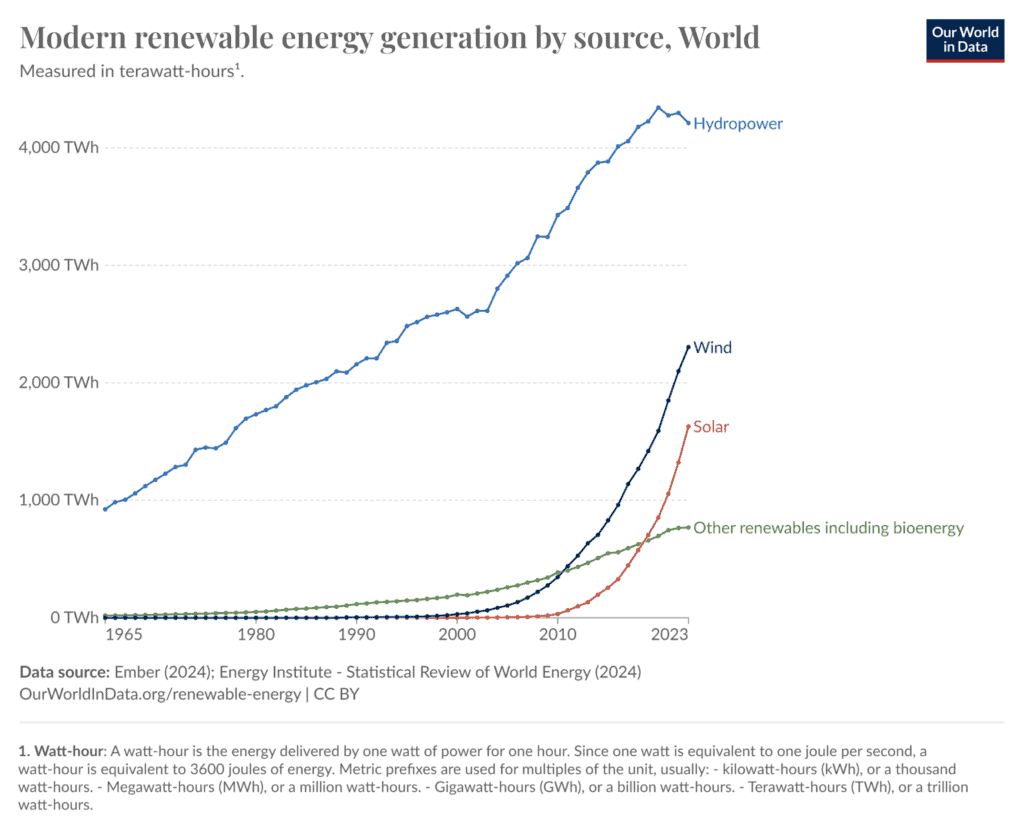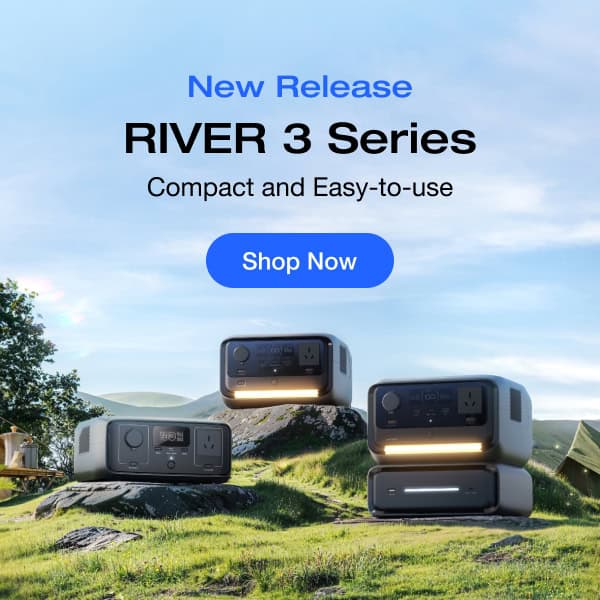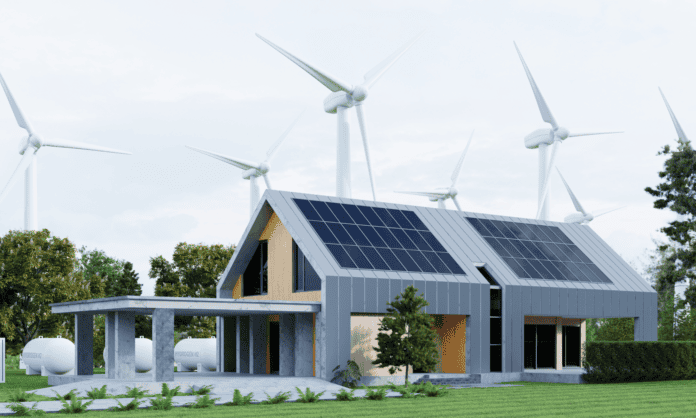Table of Contents
2023 was the hottest year ever in Australia’s recorded history.
With heatwaves breaking high-temperature records worldwide, 2024 could be even hotter.
And it’s not just the heat.
With extreme weather events like Cyclone Ellie, heavy flooding, and raging wildfires, the reality of climate change is becoming more visible in daily life.
Not something measured on a chart.
Transitioning away from burning fossil fuels towards generating electricity from renewable energy sources like wind and solar is a necessity.
Wind turbines are an essential part of reaching net zero carbon emissions and are the second-leading renewable source of electricity.
So, how do wind turbines work?
And what are they exactly?
What Is a Wind Turbine?
A wind turbine is a device that converts the kinetic energy of wind into mechanical power and mechanical power into alternating current (AC) electricity.
Wind turbines come in many different models and sizes, but most fall under the horizontal axis wind turbine (HAWT) type.
Currently, the most common type of HAWT has 3 spinning blades and a rotor on the outside, with an interior generator and power conditioning components mounted on a high, unobstructed tower.
The blades capture the kinetic energy of wind and convert it into mechanical power, which then gets transformed into electricity.

Most wind turbines provide utility-scale power, largely because of the substantial footprint they require.
In 2023, wind was second only to hydropower in electricity generation from renewable sources, with over 2,300 terawatt hours (TWH) produced globally.
However, photovoltaic (PV) solar power systems are by far the most popular for small-scale and residential applications.
(Source: Green Mechanic)
What Are the Main Components of Wind Turbines?
Most utility-scale wind turbines operate using a horizontal axis system.
Some small residential wind systems use a vertical axis, but it’s far less common.
Here are the basic components of a horizontal-axis wind turbine (HAWT).
- Blades
- Rotor
- Pitch
- Brakes
- Low-speed shaft
- Gearbox
- Generator
- Wind vane
- Nacelle
- High-speed shaft
- Yaw drive
- Yaw motor
- Tower
Types of Wind Turbines
There are two primary types of wind turbines: horizontal or vertical axis.
The large turbines you’re used to seeing on wind farms are horizontal axis, which is the more well-established technology.
Vertical-axis turbines produce less electricity from the available wind power but are sometimes found in small residential systems or specialised applications.
Horizontal-Axis Turbines
Horizontal axis wind turbines (HAWT) have the familiar 3 spinning blades and a rotor mechanism mounted on a tower construction that most people associate with wind power.
Looking very similar to aeroplane propellers, HAWT turbines produce almost all the electricity currently generated with wind power worldwide.
Of course, there are many different models and sizes of HAWT turbines and many manufacturers, but the basic principles are the same.
Offshore HAWT turbines are often significantly larger than on-land models.
For example, the CSSC Haizhuang H260-18MW offshore turbine can produce up to 18MW of electricity — enough to power up to 40,000 homes.
That kind of power comes with a big footprint: the 260m rotor diameter requires many football fields of unobstructed space for swept area.
Vertical-Axis Turbines
Unlike HAWT, vertical-axis wind turbines (VAWT) remain a relatively rare sight.
However, in recent years, numerous startups have begun to market and produce “innovative” VAWT turbines as renewable energy systems for small-scale and residential use.
Many VAWT designs are visually impressive and more aesthetically pleasing than traditional HAWT turbines.
However, VAWT offers substantially lower energy efficiency than HAWT turbines, meaning they generate far less electricity from available wind power.
For most homeowners, photovoltaic solar panel systems remain the best option for clean, renewable power.
In some locations, VAWT may offer the following advantages over HAWT turbines:
- Less Space Required: The footprint and height of VAWT can be substantially lower than HAWT
- Quieter and More Aesthetically Pleasing
- Omnidirectional: More adaptable to wind direction than HAWT
- Cost Savings: Installation costs tend to be lower
How Do Wind Turbines Work?
Before investing in a wind project of any size — from a wind farm to a small wind energy turbine-measuring wind energy potential at the proposed location is essential.
Fortunately, Australia has an abundant “supply” of wind, particularly in the southern regions like Tasmania and the Western Victoria coast.
Studies also show that “Australia has some of the best offshore wind resources in the world.”
(Source: Norton Rose Fulbright)
Multiple offshore wind projects have been planned, but there have been many delays in construction due largely to regulatory uncertainty and community concerns.
Despite Australia’s plentiful wind energy resource, there are still many barriers to adoption — both at the utility-scale and, especially, at the residential level.
The main problem?
Wind turbines are BIG.
The US Department of Energy estimates that the average homeowner needs at least one acre of unobstructed land to install a wind turbine that significantly contributes to their residential electricity needs.
Big or small, here’s a step-by-step summary of how wind turbines work.
(Source: Creative Commons)
Measuring Wind Energy Potential
There are numerous free online tools that everyone from policymakers to homeowners can use to estimate the wind energy potential by location.
Determining how much electricity can be generated from renewable energy based on historical data is never 100% accurate, particularly given the rapid changes in climate happening worldwide.
However, it’s essential to forecasting future electricity generation potential.
If you’re considering building a small wind turbine on your property, consult a local installer.
Unlike solar generator systems, installing a wind turbine is not a DIY project.
Wind Turbine Planning and Installation
Understandably given their large footprint, there’s significant regulation of wind turbine projects.
Planning permission and permits required for wind turbines vary by state — contact your local energy authority to learn more.
The NSW Small Wind Turbine Consumer Guide is an example of the government resources available.
As long as there’s sufficient space, turbines — large and small — are relatively easy for professionals to install.
Most come in “kits” with all the components required, including the rotor, tower, and balance of system.
Harvesting Wind Power
Once the turbine is installed and connected to the utility grid (or battery storage for off-grid systems), it’s time to start harvesting wind power.
At the most basic level, “Wind is created by the unequal heating of Earth’s surface by the sun.”
Like solar and hydropower, wind energy is intermittent and constantly changes direction and speed.
The amount of electricity a turbine can generate is primarily determined by the velocity at which wind spins the turbine blades and rotor.

(Source: ResearchGate)
Turning the Turbine Blades and Rotor
The turbine blades and rotor spin, collecting kinetic energy from wind and converting it to mechanical power by rotating the shaft.
Power Generation
In most HAWT turbines, a gearbox controls the rotational velocity of a low-speed shaft, which helps prevent damage to the mechanism.
The gearbox is part of the generator system, which also includes:
- Electrical generator
- Control electronics
- Adjustable speed drive or continuously variable transmission (CVT)
- High-speed shaft that rotates at sufficient speed to generate electricity

(Source: ResearchGate)
The generator produces alternating current (AC) power — also known as household electricity.
Power Conditioning
The unprocessed AC electricity produced by wind turbines is “dirty” power.
Not dirty in the sense that it produces carbon emissions like burning fossil fuels, but because the frequency and voltage of the AC electricity are highly variable.
For virtually all modern applications, the electricity produced by a wind turbine generator requires further conditioning before being consumed or transmitted to the utility grid.
The basic principle of turbine conditioning is to convert AC to direct current (DC) with a rectifier, then turn it back to AC electricity using an inverter.
The conditioning process results in much cleaner AC output with fixed frequency and voltage, resulting in much “cleaner” electricity with less “noise” (total harmonic distortion or THD).
Power conditioning is a necessity for grid-connected wind turbines or off-grid wind systems that rely on battery storage.
Transmission to the Utility Grid or Storage
Like all renewable energy sources, wind power is intermittent.
Off-grid and hybrid photovoltaic systems like solar generators rely on solar battery storage.
When electricity consumption exceeds production, grid-tied home solar panel systems auto-switch to utility power.
Just like how solar panels don’t work at night, extended periods where a wind turbine produces little to no power are inevitable.
Wind speed and direction also vary constantly, impacting how much electricity a wind turbine can produce.
All wind turbine systems must be connected to the utility grid or battery storage.
Applications of Wind Turbines
Electricity generated by wind turbines is essential to the renewable energy transition.
| Renewable Energy Sources in Australia (2021-2022) | ||||
| Household Electricity Use (PJ) | Solar Energy (PJ) | Wind Energy (PJ) | Hydro energy (PJ) | |
| 2010-11 | 201.5 | 5.5 | 12.7 | 59.0 |
| 2011-12 | 199.7 | 9.2 | 16.0 | 49.5 |
| 2012-13 | 196.9 | 13.8 | 24.4 | 64.8 |
| 2013-14 | 187.7 | 15.9 | 31.3 | 64.5 |
| 2014-15 | 189.4 | 19.9 | 39.4 | 48.2 |
| 2015-16 | 191.2 | 24.6 | 43.4 | 54.9 |
| 2016-17 | 192.9 | 29.1 | 45.2 | 58.5 |
| 2017-18 | 194.0 | 35.7 | 54.3 | 57.4 |
| 2018-19 | 191.5 | 53.5 | 63.8 | 57.5 |
| 2019-20 | 192.5 | 75.7 | 71.2 | 54.5 |
| 2020-21 | 195.4 | 99.8 | 89.3 | 54.8 |
| 2021-22 | 194.2 | 124.9 | 104.6 | 61.3 |
| Source: Australian Bureau of Statistics, Energy Account, Australia 2021-22 financial year | ||||
The most recent government figures show that wind was second only to solar power in electricity generation from renewable energy sources.
Wind and solar electricity production combined exceeded total household electricity consumption in Australia for the first time in 2021-2022.
By far the most common application of wind turbines is large-scale utility-level electricity generation.
Because wind turbines require a substantially larger footprint than photovoltaic (solar) electricity systems, they are rarely used by individual households.
However, Small Wind Energy systems do exist and may be an option for some landowners.
Here are the most common applications of wind turbines in Australia.
Wind Farms
There are almost 50 large-scale wind farms currently operating in Australia, with several more under construction.
(Source: Stockyard Hill Wind Farm)
Stockyard Hill Wind Farm in Victoria currently produces the most electricity with 530MW (megawatts) installed capacity using 149 turbines.
The Clean Energy Council says, “Wind power is currently the cheapest source of large-scale renewable energy.”
Despite being a vital source of clean, renewable energy, the construction of wind farms in Australia is not without its share of controversy.
Due to their size, appearance, and vast swathes of land required, many communities of so-called “NIMBYs” protest against having wind farms in their “backyard.”
Wind farms also have a bad reputation, with some conservationists citing their negative impact on birdlife.
However, Re-Alliance claims wind power is 35 times safer for birdlife than fossil fuels.
In addition to land-based wind farms, Australia has the potential to be “a global offshore wind superpower.”
According to the Climate Council, “If all the current proposed offshore wind farms were built, their combined energy capacity would be greater than all of Australia’s coal-fired power stations.”
Planning and construction of the first offshore wind farms are proceeding in locations near the NSW coast and the Bass Strait in Tasmania, but not without “strong opposition” from nearby residents.
Despite concerns about utility-scale wind farms — both onshore and offshore — wind turbines are an increasingly essential part of Australia’s clean energy future.
Small Wind Turbine Energy Systems
Despite increased interest and investment from private companies and governments in small wind energy systems and residential wind turbines, there hasn’t been much consumer adoption.
Purchasing and installing a wind turbine on your property is substantially more difficult — and expensive — than opting for residential solar power.
In most parts of Australia, the high number of peak sun hours and level of solar irradiance make grid-tied, off-grid, and hybrid solar panel systems a far more viable option wind with a better return on investment.
Frequently Asked Questions
Turbines utilise blades and a rotor mounted on a tower to capture the kinetic energy of wind and convert it into mechanical power. The blades rotate a low-speed shaft that’s connected to a gearbox and generator system that converts mechanical energy into alternating current (AC) electricity. An inverter conditions the power for transmission to the utility grid or battery storage.
Final Thoughts
Wind turbines may not be pretty, but they’re an essential part of Australia’s renewable energy future.
When it comes to wind power, Australia is one of the richest countries in the world as measured by energy potential.
It is estimated that offshore wind turbines alone have the potential to generate 100 times the installed capacity of Australia’s two largest electricity networks.
However, wind turbines are rarely practical for standalone or residential use.
Fortunately, we also get massive amounts of sunshine and whole home solar generators like EcoFlow DELTA Pro are convenient and affordable.
Check out EcoFlow’s selection of off-grid and hybrid solar power solutions today.


